West Bering Sea large marine ecosystem
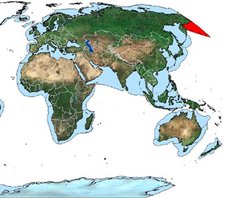 Location of the West Bering Sea LME. (Source: NOAA)
Location of the West Bering Sea LME. (Source: NOAA) The West Bering Sea large marine ecosystem (LME) lies off of Russia’s northeast coast and faces the USA coast in Alaska. The Bering Sea is customarily analyzed as east and west units with respect to ecosystems. The West Bering is generally deeper than the East Bering Sea and has different marine species. Its bottom topography includes the deep Aleutian basin. It is influenced by the very cold Subarctic Current and is dominated by storms. A physical driving force in this LME is the annual formation of sea ice. LME book chapters and articles pertaining to this LME include Morgan, 1989, and Ray and Hayden, 1993.
Contents
- 1 Productivity
- 2 Fish and Fisheries
- 3 Pollution and Ecosystem Health
- 4 Socioeconomic Conditions
- 5 Governance
- 6 References
- 6.1 Articles and LME Volumes Morgan, J., 1989. Large Marine Ecosystems in the Pacific Ocean. In K. Sherman, L.M. Alexander, and B.D. Gold, eds. Biomass Yields and Geography of Large Marine Ecosystems. AAAS Selected Symposium 111. Westview Press. Boulder CO. 377-394. ISBN: 0813378443 (West Bering Sea large marine ecosystem) . * Ray, Carlton G. and B.P. Hayden, 1993. Marine Biogeographic Provinces of the Bering, Chukchi, and Beaufort Seas. In: Large Marine Ecosystems—Stress, Mitigation, and Sustainability. K. Sherman, L.W. Alexander and B.D. Gold, eds. AAA Press. 175-185. ISBN: 087168506X.
- 6.2 Other References
- 6.3 Citation
Productivity
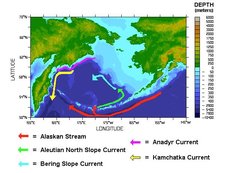 (Source: NOAA)
(Source: NOAA) For a bathymetry map of this LME, see NOAA's Bering Sea page. Sea ice dynamics is a driving force of productivity in this region. The LME contains a variety of biological resources adapted to sea ice. They include 450 species of fish, crustaceans and mollusks, and 25 species of marine mammals such as polar bears, whales, walruses, and sea lions. The Bering Sea provides an important habitat for gray whales, endangered (IUCN Red List Criteria for Endangered) Stellar sea lions and a variety of seabirds. The West Bering Sea LME is considered a Class II, moderately high (150-300 grams of carbon per square meter per year) productivity ecosystem based on SeaWiFS global primary productivity estimates. The National Academy Press has produced a digital volume on The Bering Sea Ecosystem, which can provide additional information from an ecosystems perspective. The Pacific Oceanological Institute in Vladivostok provides on-line information about the LME’s oceanography. Over the past century, the extent of the winter pack ice has decreased. In the winter of 2001, the Bering Sea was effectively ice free.
Fish and Fisheries
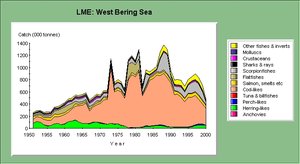 (Source: Sea Around Us)
(Source: Sea Around Us) The West Bering Sea LME has the largest fish biomass in the world for Pacific cod and cod-like fishes. Other species harvested include salmon, Alaskan pollock, walleye pollock, flatfish, rockfish, halibut, flounder, herring, squid and a variety of crab species and other crustaceans. For more information about higher trophic levels and fisheries in this LME, see The Bering Sea Ecosystem (1996). There have been large and sudden population fluctuations in these species. It is unknown why salmon catches and trout are declining in the Bering Sea. A major problem is the illegal fishing taking place in the West Bering Sea and in the “Donut Hole” which does not come under the jurisdiction of either Russia or the USA (Alaska). The poaching supplies Russia and the United States with a significant part of their fish harvests. It puts numerous marine species at risk, and contributes to the collapse of fisheries in this LME. Catches are illegally transferred to Russian carrier vessels bound for ports in Japan, South Korea, China, the United States and Canada. The Russian government seems unable to prevent this. There is evidence of fishing in prohibited areas, use of prohibited gear, and concealed harvests. Fishermen have provided distorted data on the volume and size of fish caught and the species composition of the catch. The rise of industrial fishing in the area has also had a major impact. Factory trawlers are overfishing the LME. Japanese fishing boats are using destructive driftnet fishing gear. High levels of bycatch associated with drift-netting are a major threat. For more information on fish, see Hood, 1983. The Bering Sea volume has a section on higher trophic levels and Human Use - Fisheries. The University of British Columbia Fisheries Center has detailed fish catch statistics for this LME.
Pollution and Ecosystem Health
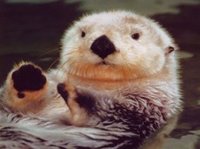 (Source: NOAA)
(Source: NOAA) Overfishing, oil production, and other anthropogenic factors are some of the issues of the Bering Sea global commons. Signs of ecosystem stress include the decline of the Bering Sea Alaskan pollock catch and the decline in numbers of the North Pacific Stellar sea lion and sea otter populations. The poaching of sockeye salmon for their eggs is preventing the salmon from reaching their spawning grounds in the Pacific. Petroleum and other contaminants have been found in marine mammals, which is evidence of the growing industrialization of the region. The Bering Sea has low levels of toxic contaminants, but these have been rising over the last 50 years due to increased human activities (mining, fishing, and oil exploration). This increase is linked to the long-range transport of contaminants through the ocean and atmosphere from other regions. Cold region ecosystems such as the Bering Sea are more sensitive to the threat of contaminants because the breakdown of these contaminants is delayed in colder areas. Also, animals high in the food web with relatively large amounts of fat tend to have high concentrations of organic contaminants such as pesticides, herbicides and PCBs. Russia today is faced with the environmental problems inherited from the Soviet Union. Russian regional authorities and multi-national oil companies are pushing for further oil exploration and development in these fragile ecosystems. However, the Russian Supreme Court has invalidated a governmental decree issued by former Prime Minister Stepashin that would have allowed marine discharge of toxic wastes from oil drilling off Russia's far east coast. For more information on chemical inputs and trace heavy metals, see Hood, 1983.
Socioeconomic Conditions
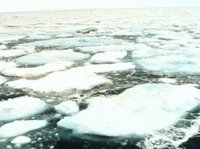 (Source: NOAA)
(Source: NOAA) Fish and game have supported the lives of people on both sides of the Bering Sea for many centuries. Marine mammal hunting has been a part of the traditional economy of the indigenous coastal [[population]s]. They are provided with an annual quota to harvest whales, ringed seals, and walruses. Marine mammals are used for food, skins and fat. The demand for furs and whale oil grew in the 18th and 19th century. In more recent times, Russian and Ukrainian immigrants were attracted to the LME’s [[coast]al areas] because of high salaries and the prospects of oil profits. Today, in the context of the new Russian economy, salaries are not higher than in other regions of Russia. With the decline of fish stocks and onshore fish processing in Kamchatka, local fishermen are losing their jobs and their profits. People have resorted to illicit ways of eking out a living. Salmon poaching for red caviar is rife, even in protected areas. The eggs command an increasingly high price in Moscow and in Japan. A major city is Anadyr (population 13,000), a seaport on the northern Pacific sea route. Most of the area’s population are immigrants from Russia and Ukraine. There is a small native population. In recent years, people have begun to migrate away from this region. Tourism is almost non-existent but there is huge economic potential. For more information on renewable and non-renewable resources, see Hood, 1983.
Governance
The West Bering Sea Large Marine Ecosystem is bordered by Russia. Other users of the marine environment such as the USA and Japan play a role in impacting the biological resources of the Bering Sea, one of the most important fisheries (Fisheries and aquaculture) areas in the world. The region is a global commons that requires international cooperation if the fish [[population]s] are not to be depleted. Areas that need to be addressed are conservation strategies, legal issues, fisheries economics, and scientific monitoring. Coordination is critical for the sustainable use of the Bering Sea fisheries. Attempts on the Russian side to deal with management issues and the poaching problem have failed due to a lack of appropriate legislation and weak enforcement. Shareholders, which include fishermen, industry leaders, anti-oil activists and fisheries conservationists, must find collaborative solutions to some of these problems. In the Russian political arena, a stable society based on citizen involvement in local, regional, and national affairs has yet to develop. Under the former Soviet system, Russians were accustomed to having the government define such aspects of their lives. Fishery policies continue to be set by Moscow bureaucrats, and are deemed not to benefit fishermen. At the same time, Russian fishing quotas are being sold to foreign countries. There is a lack of transparency in fisheries policy decision-making, with the quota discussion remaining secret. Local environmental groups are opposing further oil exploration in the Bering Sea. They point out that oil exploitation would adversely impact Russia's vital fisheries economy, which supports many local communities. They also maintain that oil exploitation presents an environmental threat. More information is available on the 2001 Bering Sea Fisheries Conference with USA and Russian organizations.
References
Articles and LME Volumes Morgan, J., 1989. Large Marine Ecosystems in the Pacific Ocean. In K. Sherman, L.M. Alexander, and B.D. Gold, eds. Biomass Yields and Geography of Large Marine Ecosystems. AAAS Selected Symposium 111. Westview Press. Boulder CO. 377-394. ISBN: 0813378443 (West Bering Sea large marine ecosystem) . * Ray, Carlton G. and B.P. Hayden, 1993. Marine Biogeographic Provinces of the Bering, Chukchi, and Beaufort Seas. In: Large Marine Ecosystems—Stress, Mitigation, and Sustainability. K. Sherman, L.W. Alexander and B.D. Gold, eds. AAA Press. 175-185. ISBN: 087168506X.
Other References
- Bakkala, R.G. and L.-L. Low, eds. 1986. Condition of groundfish resources of the eastern Bering Sea and Aleutian Islands region in 1985. U.S. Dept. of Commerce, NOAA Tech. Mem. NMFS F/NWC-104.
- The Bering Sea Ecosystem (1996), Commission on Geosciences, Environment and Resources.
- Hood, D.W., 1983. The Bering Sea. In: Ecosystems of the World—estuaries and enclosed seas. B.H. Ketchum, editor. Elsevier Scientific Publishing Company. 377-374.
- Loughlin, Thomas R. and Kiyotaka Ohtani, 1999. Dynamics of the Bering Sea--A Summary of Physical, Chemical, and Biological Characteristics,and a Synopsis of Research on the Bering Sea. North Pacific Marine Science Organization (PICES). ISBN: 1566120624.
- NOAA. 1991. Report of the ad hoc Committee on Large Marine Ecosystems. NOAA Technical Memorandum NMFS-F/NEC-92, 19p.
- Shuntov, V.P., L.A. Borets, and E.P. Dulepova. Ecosystems of the Far East Seas and state-of-the-art review. In Russian.
- Sokolovskij, A.S. and S. Yu Glebova. 1985. Long-term fluctuations of walleye pollock abundance in the Bering Sea. Izv. TINRO 110: 38-42. In Russian.
| Disclaimer: This article is taken wholly from, or contains information that was originally published by, the National Oceanic and Atmospheric Administration (NOAA). Topic editors and authors for the Encyclopedia of Earth may have edited its content or added new information. The use of information from the National Oceanic and Atmospheric Administration (NOAA) should not be construed as support for or endorsement by that organization for any new information added by EoE personnel, or for any editing of the original content. |